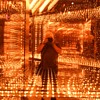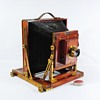Posted 11 years ago
 rniederman
rniederman
(346 items)
Although it looks old and worn, this camera is historically significant in reshaping the industry with the introduction of a new design. It represents one of the earliest appearances of tapered or ‘cone’ shaped bellows invented by Charles George Hood Kinnear in 1857. It doesn’t sound like a big deal, but this simple improvement in bellows design paved the way for many companies – including Kodak – to sell millions of amateur folding roll film cameras throughout the early 1900s.
This is the only known example of a Kinnear style camera made by the revered English builder Thomas Ottewill. (I recently sold the camera to a collector of British equipment.) The format is 10” x 8” and it is quite large for a seemingly portable camera; then again, there were no truly portable cameras before Kinnear. I spent several years researching CGH Kinnear, and in 2006 wrote a paper that was carried in several camera societies’ publications. Here is an excerpt from it:
Following Louis Daguerre’s astonishing announcement of the first practical photographic process in 1839, itinerant photographers realized that large format “camera-boxes” – as cameras were called at the time – were needed to create high quality pictures, and camera-boxes that made big images were heavy, bulky and burdensome. Over the years, it virtually became a universal wish for the creation of a practical traveling outfit. While there were several attempts at making a truly portable large format camera, nearly 20 years would pass before a successful, widely accepted design became available to the photographic community.
The breakthrough camera was built in early 1857 and described to members of the Photographic Society of Scotland by Charles George Hood Kinnear later that year in December. Camera makers of the time and collectors today refer to the innovative body pattern as simply the “Kinnear Camera” or “Improved Kinnear Camera.” Yet this significant but relatively unknown design was at least 25 years ahead of its time and intentional: inspired by a desire to make travel more convenient during photographic outings:
“I have been particular in describing my apparatus and other photographic “effects,” because I thought it might be useful to some of our members who may next season make their first excursion abroad with their cameras, and who might have some difficulty in deciding what part of their large home stock of apparatus and chemicals would be sufficient for their tour.” (Source - CGH Kinnear, Abstract of an Account of an Architectural and Photographic Tour in the North of France. Journal of the Photographic Society. December 21, 1857)
Kinnear’s motivation to create a smaller form, large format camera was almost certainly the result of being laden with a large cargo of equipment and plates during an 1856 photographic tour to Milan, Italy. How much equipment is sufficient without being overly cumbersome? It’s a question the growing number of traveling photographers often pondered while carefully considering the contents of their photographic outfits for upcoming trips. The question must also have been on Kinnear’s mind. At the end of August 1857, he and two fellow society members would set forth on an architectural and photographic tour through the Northern Provinces of France starting in the town of Rouen. However, experience from the 1856 trip encouraged him to plan ahead:
“As our route was to embrace a district in which there are as yet no railways, and only small and incommodious diligences, it was of importance to reduce the bulk and weight of our luggage as much as possible.”
For their second tour, Kinnear’s portmanteau held all the necessities for processing waxed-paper negatives during an extended photographic trip: a portfolio of waxed iodized paper, blotting paper, papier-mâché dishes and various bottles of chemistry, a scale and measuring glass, large pins, a gutta-percha funnel, horn-forceps and towels. But on this journey, the large two section travel case also held a unique camera. While his companions carried 11 x 9 inch format folding cameras by the renowned maker Thomas Ottewill, Kinnear packed a larger format (12½ x 10½ inch), “flexible-bodied” portable camera built to his specifications.
The creation of Kinnear’s camera is its own fascinating story. There are three distinct themes. The first is a camera intentionally created; born of the desire to make travel with a large format photographic apparatus more convenient. Kinnear’s apparatus set the standard for portable hand and stand cameras largely due to the invention of a conical form bellows. Combining the tapered bellows with a simpler wood frame overcame limitations of the incumbent sliding-box design in terms of weight and size. This bellows design, along with Kinnear's other innovative thinking, led to the creation of features that would be incorporated into camera design for many years to come. The reversible-bellows, used by Anthony in the 1880s, as well as the amazingly prolific American self-casing, red-bellows pattern cameras that dominated the 1890s owe their heritage to the ideas developed by Kinnear.


































Thanks, Phil!
Thanks, David!
Wow...thanks for the history! I have been going through old family photos & tin types and found this fascinating!
Just curious...I have some large, separated rectangular negatives in the material I've been going through. They measure roughly 4.5" by 2.5". Any idea what sort of camera would have taken them?
Hi thegirlnextdoor ... most any large format camera could have made the negatives using a mask. There is also the possibility that these negatives were made by a film pack. For example, 2-1/2" x 4-1/4" was popular (6.5 x 11 cm) from about 1909 to 1955. Roll films were also a possibility. If the negative material is stiff, it could be from a cut sheet used by a view camera. If the material is flexible, it could be a film pack or roll film.
Thanks, aghcollect!
Thanks, AntigueToys!
Thanks, vetraio50!
Thanks, Michael!
Thanks, Perry!
Happy Thanksgiving Rob!!!! beautiful camera!!
Thanks, Sean! Same to you!
Your very welcome Rob!!!! and Thankyou as well!!!
Thanks, Designer!
Thanks, Eric!
Thanks, Bootson!
Thanks, Chevelleman69!
Thanks, catteann and Jono!
Thanks, f64imager!
Thanks, crswerner!
Thanks, tom61375!
Thanks, chrissylovescats!
Thanks, trukn20!
Thanks, mtg75!
Thanks, michaeln544!
Thanks, sugargirl!
Thanks, Manikin!
Thanks, petey!
Thanks, Leah!
Thanks, Dan121156!
Thanks, fortapache!
Thanks, Nima!
Bumping this to the top!
Thanks, Ben!